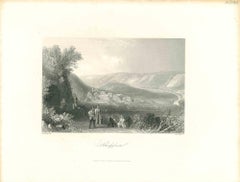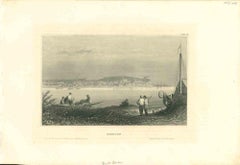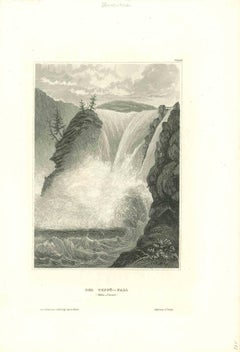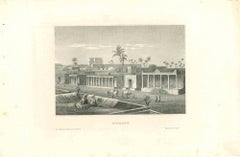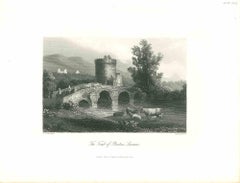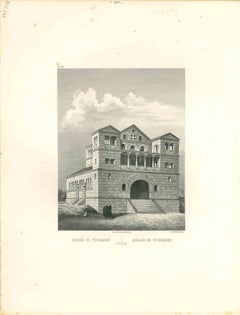Mid-19th Century Landscape Prints
to
22
708
199
29
17
2
Overall Width
to
Overall Height
to
508
19
11
5
3
1
87
48
34
22
18
1,016
2,084
9,946
4,105
117
117
687
517
591
1,113
1,480
1,729
1,297
600
657
701
253
1
579
201
179
125
121
92
91
80
78
72
62
60
52
51
49
48
44
41
39
34
641
188
117
103
54
66
698
399
262
Period: Mid-19th Century
Ancient View of Schulpforte - Original Lithograph - Mid 19th Century
Located in Roma, IT
Ancient View of Schulpforte is an original modern artwork realized in Germany in the Mid-19th Century.
Original B/W Lithograph on Ivory Paper.
Inscripted on the lowet margin in Ca...
Category
Modern Mid-19th Century Landscape Prints
Materials
Lithograph
Ancient View of Semlin - Original Lithograph - Mid 19th Century
Located in Roma, IT
Semlin is an original modern artwork realized in Germany in the Mid-19th Century.
Original B/W Lithograph on Ivory Paper.
Inscripted on the lowet margin in Capital Letters: Semlin...
Category
Modern Mid-19th Century Landscape Prints
Materials
Lithograph
Der Toppo - Fall - Original Lithograph - Mid 19th Century
Located in Roma, IT
Der Toppo - Fall is an original modern artwork realized in Germany in the Mid-19th Century.
Original B/W Lithograph on Ivory Paper.
Inscripted on the lowet margin in Capital Lette...
Category
Modern Mid-19th Century Landscape Prints
Materials
Lithograph
Ancient View of Mursuk - Original Lithograph - Mid 19th Century
Located in Roma, IT
Ancient View of Mursuk is an original modern artwork realized in Germany in the Mid-19th Century.
Original B/W Lithograph on Ivory Paper.
Inscripted on the lowet margin in Capital...
Category
Modern Mid-19th Century Landscape Prints
Materials
Lithograph
The Tomb of Plautius Lucanus - Original Lithograph - Mid 19th Century
Located in Roma, IT
The Tomb of Plautius Lucanus is an original modern artwork realized in Germany in the Mid-19th Century.
Original B/W Lithograph on Ivory Paper.
Inscripted on the lowet margin in C...
Category
Modern Mid-19th Century Landscape Prints
Materials
Lithograph
Tourmanin Church - Original Lithograph - Mid-19th Century
Located in Roma, IT
Tourmanin Church is an original modern artwork realized in Germany in the mid-19th Century.
Original B/W Lithograph on Ivory Paper.
Inscripted on the central margin in Capital Let...
Category
Modern Mid-19th Century Landscape Prints
Materials
Lithograph
Temple d'Antonine et de Faustine - Original Lithograph - Mid-19th Century
Located in Roma, IT
Temple d'Antonine et de Faustine is an original modern artwork realized in Germany in theMid-19th Century.
Original B/W Lithograph on Ivory Paper.
Inscripted on the lowet margin i...
Category
Modern Mid-19th Century Landscape Prints
Materials
Lithograph
Ancient View of Pont Rouge in Saint Petersburg - Original Lithograph - 1850s
Located in Roma, IT
Ancient View of Pont Rouge in Saint Petersburg is an original modern artwork realized in France in the first half of the 19th Century.
Original B/W Lithograph on Ivory Paper.
Insc...
Category
Old Masters Mid-19th Century Landscape Prints
Materials
Lithograph
Das Troizker Sergiuskloster - Original Lithograph - Mid-19th Century
Located in Roma, IT
Das Troizker Sergiuskloster is an original modern artwork realized in Germany in the first half of the 19th Century.
Original B/W Lithograph on Ivory Paper.
Inscripted on the lowe...
Category
Old Masters Mid-19th Century Landscape Prints
Materials
Lithograph
Ancient View of Place des Boutiques in Moscow - Original Lithograph - 1850s
Located in Roma, IT
Ancient View of Place des Boutiques in Moscow is an original modern artwork realized in France in the first half of the 19th Century.
Original B/W Lithograph on Ivory Paper.
Inscr...
Category
Old Masters Mid-19th Century Landscape Prints
Materials
Lithograph
Ancient View of Caucasus - Original Etching - Mid-19th Century
Located in Roma, IT
Ancient View of Caucasus is an original modern artwork realized in Germany in the first half of the 19th Century.
Original B/W Lithograph on Ivory Paper.
Inscripted on the lower m...
Category
Old Masters Mid-19th Century Landscape Prints
Materials
Etching
Ancient View of View on the Amstel - Original lithograph - Mid-19th Century
Located in Roma, IT
View on the Amstel is an original modern artwork realized in Italy in the mid of the 19th Century.
Original B/W Lithograph on Ivory Paper.
Inscripted on the lower margin: Vien on ...
Category
Modern Mid-19th Century Landscape Prints
Materials
Lithograph
Ancient View of Arnheim - Original lithograph - Mid-19th Century
Located in Roma, IT
Arnheim is an original modern artwork realized in Italy in the mid of the 19th Century.
Original B/W Lithograph on Ivory Paper.
Inscripted on the lower margin: Arnheim. Engraved b...
Category
Modern Mid-19th Century Landscape Prints
Materials
Lithograph
Ancient View of Amersfoor - Original lithograph - Mid-19th Century
Located in Roma, IT
Amersfoort is an original modern artwork realized in Italy in the first half of the 19th Century.
Original B/W Lithograph on Ivory Paper.
Inscripted in capital letters on the lowe...
Category
Modern Mid-19th Century Landscape Prints
Materials
Lithograph
Die Heilihe Stadt - Original Lithograph - Mid-19th Century
Located in Roma, IT
Die heilihe Stadt is an original modern artwork realized in the mid of of the 19th Century.
Original B/W Lithograph on Ivory Paper.
Inscripted on the lower margin.
Sheet dimensio...
Category
Modern Mid-19th Century Landscape Prints
Materials
Lithograph
Ancient View of the Doge Palace Venice - Original Lithograph - 19th Century
Located in Roma, IT
Ancient View of the Doge Palace in Venice (original title: Der Dogenpallast) is an original modern artwork realized in the first half of the 19th C...
Category
Modern Mid-19th Century Landscape Prints
Materials
Lithograph
Strada St. Giovanni, Valetta - Original Lithograph - Early-19th Century
Located in Roma, IT
Strada St. Giovanni, Valetta is an original modern artwork realized in Italy in the first half of the 19th Century.
Original Lithograph on Ivory Paper.
Inscripted in capital lette...
Category
Modern Mid-19th Century Landscape Prints
Materials
Lithograph
Ancient View of La Valetta - Original Lithograph - Early-19th Century
Located in Roma, IT
La Valetta is an original modern artwork realized in Italy in the first half of the 19th Century.
Original Lithograph on Ivory Paper.
Inscripted in capital letters on the lower ma...
Category
Modern Mid-19th Century Landscape Prints
Materials
Lithograph
Ancient View of Moscow - Original Lithograph on paper - 1850s
Located in Roma, IT
Ancient View of Moscow is an original modern artwork realized in France in the first half of the 19th Century.
Original B/W Lithograph on Ivory Paper.
Inscripted on the lower marg...
Category
Modern Mid-19th Century Landscape Prints
Materials
Lithograph
Ancient View of Taganrog - Original Lithograph on paper - 1850s
Located in Roma, IT
Ancient View of Taganrog is an original modern artwork realized in Germany in the first half of the 19th Century.
Original B/W Lithograph on Ivory Paper.
Inscripted on the lower ...
Category
Modern Mid-19th Century Landscape Prints
Materials
Lithograph
Der Keiserliche Sommerpallast - Original Lithograph - Early 19th Century
Located in Roma, IT
Der Keiserliche Sommerpallast is an original modern artwork realized in Germany in the first half of the 19th Century.
Original B/W Lithograph on Ivory Paper.
Inscripted on the l...
Category
Modern Mid-19th Century Landscape Prints
Materials
Lithograph
Ancient View of Lisbon - Original Lithograph - Mid-19th Century
Located in Roma, IT
Ancient View of Lisbon is an original modern artwork realized in the mid-19th Century.
Original B/W Lithograph on Ivory Paper.
Inscripted on the lower margin in Capital Letters: ...
Category
Modern Mid-19th Century Landscape Prints
Materials
Lithograph
Landscape in Quebec - Original Lithograph - Mid-19th Century
Located in Roma, IT
Landscape in Quebec is an original modern artwork realized in the mid-19th Century.
Original Colored Lithograph on Ivory Paper.
Inscripted on the lower margin: Quebeck.
Printed ...
Category
Modern Mid-19th Century Landscape Prints
Materials
Paper, Lithograph
Ancient View of Hallstadt - Original Lithograph - Mid-19th Century
Located in Roma, IT
Ancient View of Hallstadt is an original modern artwork realized in the mid-19th Century.
Original B/W Lithograph on Ivory Paper.
Inscripted on the lower margin in capital Letter...
Category
Modern Mid-19th Century Landscape Prints
Materials
Lithograph
Ancient View of Corynth - Original Lithograph - Mid-19th Century
Located in Roma, IT
Ancient View of Corynth is an original modern artwork realized in the first half of the 19th Century.
Original B/W Lithograph on Ivory Paper.
Inscripted on the lower margin in Ca...
Category
Modern Mid-19th Century Landscape Prints
Materials
Paper, Lithograph
Ancient View of Seida - Original Lithograph - Mid-19th Century
Located in Roma, IT
Ancient View of Seida is an original modern artwork realized in the mid-19th Century.
Original B/W Lithograph on Ivory Paper.
Inscripted on the lower margin in Capital Letters: S...
Category
Mid-19th Century Landscape Prints
Materials
Paper, Lithograph
Nazareth - Original Lithograph - Mid-19th Century
Located in Roma, IT
Ancient View of Nazareth is an original modern artwork realized in the mid-19th Century.
Original B/W Lithograph on Ivory Paper.
Inscripted on the lower margin in Capital Letters...
Category
Modern Mid-19th Century Landscape Prints
Materials
Paper, Lithograph
Ancient View ofValley of St. Nicholas - Original Lithograph - Mid-19th Century
Located in Roma, IT
Scene in the Valley of St. Nicholas is an original modern artwork realized in the half of the 19th Century.
Original B/W Lithograph on Ivory Paper.
Inscripted on the lower margin ...
Category
Mid-19th Century Landscape Prints
Materials
Paper, Lithograph
Ancient View of Jerusalem - Original Lithograph - Half of the 19th Century
Located in Roma, IT
Ancient View of Jerusalem is an original modern artwork realized in the first half of the 19th Century.
Original B/W Lithograph on Ivory Paper.
Inscripted on the lower margin in ...
Category
Modern Mid-19th Century Landscape Prints
Materials
Lithograph
Florenz - Original Lithograph - 1850 ca.
Located in Roma, IT
Florenz is an original modern artwork realized in Italy in the first half of the 19th Century.
Original Lithograph on Ivory Paper.
Inscripted on the lower margin in Capital Lette...
Category
Modern Mid-19th Century Landscape Prints
Materials
Woodcut
Ancient View of Innsbruck - Original Lithograph on Paper - Mid-19th Century
Located in Roma, IT
Ancient View of Innsbruck is an original modern artwork realized in the first half of the 19th Century.
Original B/W Lithograph on Ivory Paper.
Inscripted on the lower margin: In...
Category
Modern Mid-19th Century Landscape Prints
Materials
Lithograph
Ancient View of Messina - Original Lithograph on Paper - Mid-19th Century
Located in Roma, IT
Messina is an original modern artwork realized in Italy in the first half of the 19th Century.
Original Lithograph on Ivory Paper.
Inscripted on the lower margin in Capital Lette...
Category
Modern Mid-19th Century Landscape Prints
Materials
Lithograph
Ancient View of the Bay of Naples - Original Lithograph - Mid-19th Century
Located in Roma, IT
Ancient View of the Bay of Bay of Naples is an original modern artwork realized in Italy in the first half of the 19th Century.
Original Lithograph on Ivory Paper.
Inscripted in ...
Category
Mid-19th Century Landscape Prints
Materials
Lithograph
Ancient View of Chapel of Santa Rosalia- Lithograph on Paper - Mid-19th Century
Located in Roma, IT
Chapel of Santa Rosalia is an original modern artwork realized in Italy in the first half of the 19th Century.
Original Colored Lithograph on Ivory Paper.
Inscripted on the lower...
Category
Mid-19th Century Landscape Prints
Materials
Lithograph
Augustus Arch - Original Lithograph on Paper - Mid-19th Century
Located in Roma, IT
Augustus Arch is an original modern artwork realized in the first half of the 19th Century.
Original Lithograph on paper.
Inscripted on the lower margin in Capital Letters, in Ger...
Category
Mid-19th Century Landscape Prints
Materials
Lithograph
Ancient View of the Ghetto in Rome - Original Lithograph on Paper - 19th Century
Located in Roma, IT
Ancient View of the Ghetto in Rome is an original modern artwork realized in the first half of the 19th Century.
Original Lithograph on paper.
Inscripted on the lower margin.
Fai...
Category
Modern Mid-19th Century Landscape Prints
Materials
Paper, Lithograph
Shere Mill Pond II (Large Plate)
Located in New York, NY
Seymour Haden (1818-1910), Shere Mill Pond II (Large Plate), etching and drypoint, 1860, signed in pencil lower right [also signed in the plate lower right]. Schneiderman 37, sixth state (of 9). In generally good condition (see note below) with margins, on a cream/ivory laid paper, 7 x 13 1/2, the sheet 8 1/8 x 13 3/4 inches.
A very good impression, with rich burr especially in the reeds toward the right.
Provenance: Frederick Keppel and Co., New York, NY.
Illustrated: Guichard, British...
Category
Impressionist Mid-19th Century Landscape Prints
Materials
Drypoint, Etching
'Kettle Falls, Columbia River' original color lithograph by John Mix Stanley
Located in Milwaukee, WI
In the mid-nineteenth century, the United States government set out to survey and document its newly acquired lands and territories west of the Mississippi. The goals of these surveys were manifold: to produce topographical maps, to document flora and fauna, and to document natural resources to build the emerging US economy. These surveys, and the images from them, also functioned to build the new sense of American identity with the landscape, condensing vistas into the 'picturesque' tradition of European image making. Thus, the entire span of US territory could be seen as a single, cohesive whole.
This lithograph comes from one of six surveys commissioned by the Army's Topographic Bureau in 1853, which sought to find the best route to construct a transcontinental railroad. The result was a thirteen-volume report including maps, lithographs, and technical data entitled 'Explorations and Surveys to ascertain the most practicable and economical route for a Railroad from the Mississippi river to the Pacific Ocean.'
When it came to depicting the Columbia River, as seen in the present print, Stanley chose to depict the river's characteristic rock formations and choppy waters. The figures in the image give the viewer a sense of the vase scale of the imposing landscape. Other explorers that reached the site years before the Pacific Railroad Survey, such as Lewis and Clark, observed this scene with wonder and awe – and it is clear Stanley felt the same way.
5.75 x 8.75 inches, image
6.5 x 9.25 inches, stone
13.25 x 16.25 inches, frame
Artist 'Stanley Del.' lower left
Entitled 'Kettle Falls, Columbia River' lower center margin
Publisher 'Sarony, Major & Knapp. Lith.s 449 Broadway N.Y.' lower right
Inscribed 'U.S.P.R.R. EXP. & SURVEYS — 47th & 49th PARALLELS' upper left
Inscribed 'GENERAL REPORT — PLATE XLVII' upper right
Framed to conservation standards using 100 percent rag matting and Museum Glass to inhibit fading; housed in a brass-surface aluminium moulding.
Print in overall good condition; wrinkles in upper margin and upper right corner; frame in excellent condition.
John Mix Stanley...
Category
Romantic Mid-19th Century Landscape Prints
Materials
Lithograph
Defense of Varese by Giuseppe Garibaldi - Lithograph by F. Perrin - 1860
Located in Roma, IT
Defense of Varese by G. Garibaldi is an original artwork realized by Ferdinando Perrin in 1860.
Original hand-watercolored lithograph. Edited by C. Perrin Editore Torino.
On the lo...
Category
Modern Mid-19th Century Landscape Prints
Materials
Lithograph
Interieur de Geneve [...] - Lithograph by Antonio Fontanesi - 1850s
Located in Roma, IT
This splendid lithograph Interieur de Geneve. Fontaine de l'Hotel De Ville is part of the series of 20 prints dedicated to views of the city of Geneva, engraved by the Italian artist...
Category
Mid-19th Century Landscape Prints
Materials
Lithograph
Interieur de Geneve. Place de la Grenet - Lithograph by Antonio Fontanesi - 1854
Located in Roma, IT
This splendid lithograph Interieur de Geneve. Place de la Grenette is part of the series of 20 prints dedicated to views of the city of Geneva, engraved by the Italian artist Antonio...
Category
Old Masters Mid-19th Century Landscape Prints
Materials
Lithograph
Battle Scene - Original Lithograph by Auguste Raffet - 1859
Located in Roma, IT
Battle Scene of "Chemin De Ronde" is an original lithography artwork realized by Raffet in 1859.
Signed on the plate on the lower left, dated, titled on the lower center with descr...
Category
Mid-19th Century Landscape Prints
Materials
Lithograph
Gene - Original Lithograph - 1950 ca.
Located in Roma, IT
Gene is a beautiful original lithograph realized by Eugène Flandin (1809-1889) in 1850 ca.
Signed on the plate by the artist on the lower left margin, lithographed by Jules Collign...
Category
Mid-19th Century Landscape Prints
Materials
Lithograph
View of Geneve - Lithograph by Antonio Fontanesi - 1850 ca.
Located in Roma, IT
Image dimensions: M-109655 cm.
This splendid lithograph View of Geneve is part of the series of prints dedicated to views of the city of Geneva, engraved by the Italian artist Antonio Fontanesi.
The state of preservation of the artwork is excellent.
The signature is engraved on the plate the lower left. At the top of the paper, the inscription “Interieur de Geneve”, while at the bottom, below the image, the inscription “JMP Pilet & Cougnard Editeurs Geneve”.
Antonio Fontanesi (Reggio Emilia, 1818 - Turin, 1882) was an Italian painter, engraver, teacher, and soldier. He was one of the most important 19th-century Italian painters, though somewhat unknown. After fighting in the I Independence War...
Category
Mid-19th Century Landscape Prints
Materials
Lithograph
Defense of Varese by Garibaldi - Lithograph by Carlo Perrin - 1860
By Carlo Perrin
Located in Roma, IT
Image dimensions: 15.5x22.5 cm.
Defense of Varese by Garibaldi is a beautiful artwork realized by Carlo Perrin in 1860.
litography colored by hand, published in Turin by Carlo Per...
Category
Mid-19th Century Landscape Prints
Materials
Lithograph
View of the Military Field in Magenta - Lithograph by Carlo Perrin - 1860
By Carlo Perrin
Located in Roma, IT
Image dimensions: 15,5x22,5 cm.
Veduta del campo generale di Magenta (View of the Military Field in Magenta) is a beautiful artwork realized by Carlo Perrin.
litography colored by ...
Category
Mid-19th Century Landscape Prints
Materials
Lithograph
'Camp Red River Hunters' original lithograph by John Mix Stanley
Located in Milwaukee, WI
In the mid-nineteenth century, the United States government set out to survey and document its newly acquired lands and territories west of the Mississippi. The goals of these surveys were manifold: to produce topographical maps, to document flora and fauna, and to document natural resources to build the emerging US economy. These surveys, and the images from them, also functioned to build the new sense of American identity with the landscape, condensing vistas into the 'picturesque' tradition of European image making. Thus, the entire span of US territory could be seen as a single, cohesive whole.
This lithograph comes from one of six surveys commissioned by the Army's Topographic Bureau in 1853, which sought to find the best route to construct a transcontinental railroad. The result was a thirteen-volume report including maps, lithographs, and technical data entitled 'Explorations and Surveys to ascertain the most practicable and economical route for a Railroad from the Mississippi river to the Pacific Ocean.' In particular, the print comes from the northern survey, commanded by Isaac Stevens, which explored the regions between the 47th and 49th parallels.
In this image, Stanley shows an encampment of the people known as the Red River of the North hunters. They were generations of European and mixed-race trappers who lived on the frontier and had Indian wives and mixed-race children. They had come to the area for bison hunting, as the herds were still vast on the prairies. In the image, the figures and their encampment are dwarfed by the vast landscape around them, indicating the sublimity of these new American territories.
5.75 x 8.75 inches, image
6.5 x 9.25 inches, stone
17 x 20 inches, frame
Artist 'Stanley Del.' lower left
Entitled 'Camp Red River Hunters' lower center margin
Publisher 'Sarony, Major & Knapp. Lith.s 449 Broadway N.Y.' lower right
Inscribed 'U.S.P.R.R. EXP. & SURVEYS — 47th & 49th PARALLELS' upper left
Inscribed 'GENERAL REPORT — PLATE XII' upper right
Framed to conservation standards using 100 percent rag matting with French accents; glazed with UV5 Plexiglas to inhibit fading; housed in a gold reverse ogee moulding.
Print in overall good condition; some localized foxing and discoloration; minor surface abrasions to frame.
John Mix Stanley...
Category
Romantic Mid-19th Century Landscape Prints
Materials
Lithograph
Geneva, Rue De L'Hôtel De Ville - Lithograph by A. Fontanesi - 1854
Located in Roma, IT
Image dimensions: 20.5 x 15 cm.
This splendid lithograph Interieur de Geneve. Rue De L'Hôtel De Ville is part of the series of 20 prints dedicated to views of the city of Geneva, en...
Category
Naturalistic Mid-19th Century Landscape Prints
Materials
Lithograph
Geneva, Cour Du Collège - Lithograph by A. Fontanesi - 1854
Located in Roma, IT
This splendid lithograph Interieur de Geneve. Cour Du Collège is part of the series of 20 prints dedicated to views of the city of Geneva, engraved by the Italian artist Antonio Font...
Category
Naturalistic Mid-19th Century Landscape Prints
Materials
Lithograph
'Distribution of Goods to the Gros Ventres' lithograph by John Mix Stanley
Located in Milwaukee, WI
In the mid-nineteenth century, the United States government set out to survey and document its newly acquired lands and territories west of the Mississippi. The goals of these surveys were manifold: to produce topographical maps, to document flora and fauna, and to document natural resources to build the emerging US economy. These surveys, and the images from them, also functioned to build the new sense of American identity with the landscape, condensing vistas into the 'picturesque' tradition of European image making. Thus, the entire span of US territory could be seen as a single, cohesive whole.
This lithograph comes from one of six surveys commissioned by the Army's Topographic Bureau in 1853, which sought to find the best route to construct a transcontinental railroad. The result was a thirteen-volume report including maps, lithographs, and technical data entitled 'Explorations and Surveys to ascertain the most practicable and economical route for a Railroad from the Mississippi river to the Pacific Ocean.' In particular, the print comes from the northern survey, commanded by Isaac Stevens, which explored the regions between the 47th and 49th parallels.
In this image, Stanley documented the encounter with the Gros Ventre people at Milk River. The explorers were invited to the Gros Ventres camp and the two groups exchanged gifts in friendship. The Stevens Party provided "... blankets, shirts, calico, knives, beads, paint, powder, shot, tobacco, hard bread, etc." The image likewise alludes to how, in 1855, Isaac Stevens, concluded a treaty (Stat., L., XI, 657) to provide peace between the United States and the Blackfoot, Flathead and Nez Perce tribes. The Gros Ventres signed the treaty as part of the Blackfoot Confederacy, whose territory near the Three Fork area became a common hunting ground for the Flathead, Nez Perce, Kootenai, and Crow Indians.
5.75 x 8.75 inches, image
6.5 x 9.25 inches, stone
17 x 20 inches, frame
Artist 'Stanley Del.' lower left
Entitled 'Distribution of Goods to the Gros Ventres' lower center margin
Publisher 'Sarony, Major & Knapp. Lith.s 449 Broadway N.Y.' lower right
Inscribed 'U.S.P.R.R. EXP. & SURVEYS — 47th & 49th PARALLELS' upper left
Inscribed 'GENERAL REPORT — PLATE XXI' upper right
Framed to conservation standards using 100 percent rag matting with French accents; glazed with UV5 Plexiglas to inhibit fading; housed in a gold reverse ogee moulding.
Print in overall good condition; some localized foxing and discoloration; minor surface abrasions to frame.
John Mix...
Category
Romantic Mid-19th Century Landscape Prints
Materials
Lithograph
La Cava (The Cave) - Etching by Francesco Mochetti - 1843
Located in Roma, IT
Image dimensions: 14.7 x 19.8 cm.
La Cava is an original black and white etching on paper, printed in 1843 as a plate of the print suite "90 Views of the citi...
Category
Modern Mid-19th Century Landscape Prints
Materials
Etching
The Unsafe Tenement
Located in New York, NY
James Abbot McNeill Whistler (1834-1903), The Unsafe Tenement, etching, 1858. [signed in the plate lower right]. References: Kennedy 17. Glasgow 18, fourth state (of four). In very good condition, printed on a very thin (two ply?) Japan paper, with margins, 6 1/8 x 8 3/4, the sheet 8 1/4 x 11, archival mounting.
A brilliant, black impression printed with astonishing clarity and exquisite detailing, on an ivory Japan paper. Presumably this is a proof impression before the relatively large edition published in this state (the edition was not on this paper).
Provenance: Inscribed “To Otto J. Schneider from his friend Frederick Keppel”. Schneider (1875-1946) was an American artist, noted for his realism, influenced by Whistler. Keppel was of course the well-known American dealer, one of whose specialties was Whistler prints. Keppel had a good relationship with Whistler until, as in most of his relationships, Whistler became inordinately troublesome – at which point Keppel wrote Whistler a longish, mocking poem, with lines such as these: “Like cackling hens or cocks a-crowing Your tireless trumpet keeps a-blowing. ” After this, Keppel wrote “at this point all my intercourse with this extraordinary man came to an end.”
(In the lower right is the ghost of another inscription, now erased, apparently to another friend from Edna (?) Schneider who presumably owned this print after Otto Schneider...
Category
Realist Mid-19th Century Landscape Prints
Materials
Etching
Interieur de Geneve. Porte Neuve - Lithograph by A. Fontanesi
Located in Roma, IT
Image dimensions: 15 x 22 cm.
This splendid lithograph Interieur de Geneve. Porte Neuve is part of the series of 20 prints dedicated to views of the city of Geneva, engraved by the ...
Category
Mid-19th Century Landscape Prints
Materials
Lithograph
Au Bord d'une Rivière - Original Lithograph by A. Decamps
Located in Roma, IT
Au Bord d'une Rivière is an original artwork realized by Alexandre Decamps in 1831.
Original lithograph on paper.
Very good conditions.
Original artwork representing a river with ...
Category
Mid-19th Century Landscape Prints
Materials
Lithograph
'Distribution of Goods to the Assiniboines' original John Mix Stanley lithograph
Located in Milwaukee, WI
In the mid-nineteenth century, the United States government set out to survey and document its newly acquired lands and territories west of the Mississippi. The goals of these surveys were manifold: to produce topographical maps, to document flora and fauna, and to document natural resources to build the emerging US economy. These surveys, and the images from them, also functioned to build the new sense of American identity with the landscape, condensing vistas into the 'picturesque' tradition of European image making. Thus, the entire span of US territory could be seen as a single, cohesive whole.
This lithograph comes from one of six surveys commissioned by the Army's Topographic Bureau in 1853, which sought to find the best route to construct a transcontinental railroad. The result was a thirteen-volume report including maps, lithographs, and technical data entitled 'Explorations and Surveys to ascertain the most practicable and economical route for a Railroad from the Mississippi river to the Pacific Ocean.'
When it came to depicting the Assiniboine people, as seen in the present print, Stanley chose to juxtapose their encampment, marked by tipis in the distance, with the encampment of the Isaac Stevens survey party. In the foreground, commemorating this moment, Isaac Stevens can be seen presenting trade goods, which are known to include thirty two dressed skins and two robes. The survey leader Isaac Stevens noted being grateful for the generosity of the Assiniboine, commenting: "I felt very grateful indeed to those Indians, for their kindness to my men, their proffer of kind feeling and hospitality to myself and the survey." This description and this image, however, are arguably depicted through rose-colored glasses: to the Assiniboine people, this meeting may well have included stressful diplomatic relationships and have indicated a threat to the sovereignty over the territories agreed to be theirs by the 1851 Treaty of Fort Laramie.
5.75 x 8.75 inches, image
6.5 x 9.25 inches, stone
17 x 19.75 inches, frame
Artist 'Stanley Del.' lower left
Entitled 'Distribution of Goods to the Assiniboines' lower center margin
Publisher 'Sarony, Major & Knapp. Lith.s 449 Broadway N.Y.' lower right
Inscribed 'U.S.P.R.R. EXP. & SURVEYS — 47th & 49th PARALLELS' upper left
Inscribed 'GENERAL REPORT — PLATE XIV' upper right
Framed to conservation standards using 100 percent rag matting with French accents; glazed with UV5 Plexiglas to inhibit fading; housed in a gold reverse ogee moulding.
Print in overall good condition; some localized foxing and discoloration; frame in excellent condition.
John Mix Stanley...
Category
Romantic Mid-19th Century Landscape Prints
Materials
Lithograph
'Lieutenant Crovers Despatch – Return of Governor Stevens to Fort Benton'
Located in Milwaukee, WI
In the mid-nineteenth century, the United States government set out to survey and document its newly acquired lands and territories west of the Mississippi. The goals of these surveys were manifold: to produce topographical maps, to document flora and fauna, and to document natural resources to build the emerging US economy. These surveys, and the images from them, also functioned to build the new sense of American identity with the landscape, condensing vistas into the 'picturesque' tradition of European image making. Thus, the entire span of US territory could be seen as a single, cohesive whole.
This lithograph comes from one of six surveys commissioned by the Army's Topographic Bureau in 1853, which sought to find the best route to construct a transcontinental railroad. The result was a thirteen-volume report including maps, lithographs, and technical data entitled 'Explorations and Surveys to ascertain the most practicable and economical route for a Railroad from the Mississippi river to the Pacific Ocean.' In particular, the print comes from the northern survey, commanded by Isaac Stevens, which explored the regions between the 47th and 49th parallels.
5.75 x 8.75 inches, image
6.5 x 9.25 inches, stone
17 x 20 inches, frame
Artist 'Stanley Del.' lower left
Entitled 'Lieutenant Crovers Despatch – Return of Governor Stevens to Fort Benton' lower center margin
Publisher 'Sarony, Major & Knapp. Lith.s 449 Broadway N.Y.' lower right
Inscribed 'U.S.P.R.R. EXP. & SURVEYS — 47th & 49th PARALLELS' upper left
Inscribed 'GENERAL REPORT — PLATE XXXVII' upper right
Framed to conservation standards using 100 percent rag matting with French accents; glazed with UV5 Plexiglas to inhibit fading; housed in a gold reverse ogee moulding.
Print in overall good condition; some localized foxing and discoloration; minor surface abrasions to frame.
John Mix Stanley...
Category
Romantic Mid-19th Century Landscape Prints
Materials
Lithograph
Kom Ombo - David Roberts - Orientalist
Located in London, GB
David Roberts
1796 - 1864
Kom Ombo
First Edition lithograph
Full plate: 210
Presented in an acid free mount
Category
Mid-19th Century Landscape Prints
Materials
Lithograph
"The Betting Post At Epsom" 1836 by James Pollard
Located in Bristol, CT
Hand-colour sporting plate by James Pollard (1792-1867)
Title: Epsom, The Betting Post
Published 1836 by Ackermann & Co
Print Sz: 14"H x 19 1/2"W
Frame Sz: 20"H x 26"W
w/ birds...
Category
Mid-19th Century Landscape Prints
Materials
Lithograph
Boston
Located in Missouri, MO
John William Hill (1812-1879)
"Boston" 1857
Hand-Colored Engraving
Site Size: 29 x 41 inches
Framed Size: 39 x 52 inches
Born in London, England, John William Hill came to America with his family at age 7. His father, John Hill, was a well-known landscape painter, engraver, and aquatintist. John William had a career of two phases, a city topographer-engraver and then, the leading pre-Rafaelite school painter in this country. Employed by the New York Geological Survey and then by Smith Brothers...
Category
Pre-Raphaelite Mid-19th Century Landscape Prints
Materials
Engraving, Aquatint
Price Upon Request
